Grinding it out in Virginia, USA
Easter is often associated with the arrival of spring. In the Washington DC area, the warm weather bring about a transformation from bare branches to puffy pink trees adorned with cherry blossoms. It is also believed that the cherry blossom heralds the arrival of shads into the Potomac River – an annual event much anticipated by anglers to target these game fish.
Following the last summer visit to Virginia, Pat had planted little seeds of ideas in my fish obsessed head. These thoughts laid dormant through much of fall and early winter, until the approach of March when the dreams began to germinate and finally sprouting into a concrete plan. The plan was then set to visit the Potomac River on the Easter Weekend to experience the shad run. The early spring timing is also prime to coincide with good Chain Pickerel and Flier Sunfish fishing.
March 28, 2013
It was Thursday morning that Michael and I left Toronto at 7am. After a very scenic drive through upstate New York, between the peaks of the Appalachians in Pennsylvania and Maryland, and dropping over the Fall Line in Virginia, we finally arrived to the shores of the Potomac.
There were still a few hours of day light to fish in the late afternoon, so Michael and I worked a Chatterbait around the shorelines for a shot at the invasive Northern Snakehead. Unfortunately, 3pm was low tide and much of the usual snakehead haunts were left high and muddy. After a few hours of exploring, our effort was all for naught. Maybe we should have spent the time fishing for Blue Catfish instead.
During our time in Virginia, we were hosted by Pat and his wife Lia. We can’t thank them enough for making us feel at home and taking very good care for all our needs. There is a debt to be paid! That evening, Pat, Michael and I strategized the battle plans for the next few days over a couple of beer. I’m not sure I was able to think critically after two beers, but somehow, through my intoxicated mind seemed to remember Pat saying “…water is still cold…” or “…we need some rain…” and “…try to hold off the shad fishing until the end…” I think it was something to that effect. Thus, we would instead explore a set of blackwater ponds on Friday, look for whiskered felines and camouflaged reptilian fish on Saturday, and give it all on a raging river on Sunday.
March 29, 2013
Friday morning, I woke up a bit groggy and I think everyone were also suffering from some residual alcohol haziness. It took a while until we were out the door motoring toward Richmond. About 1.5 hours drive later we arrived in a wilderness area beside a small river. Somewhere deeper along the trail are shallow ponds that may not look much more than a duck pond to the unacquainted. In Ontario, I have often passed by these shallow looking swamps without ever thinking our scaled friends could survive in them. Perhaps the southerly longitude offered a warmer clime where shallow ponds rarely freeze solid, thus allowing the denizens of these dark waters to proliferate in such shallow habitat.
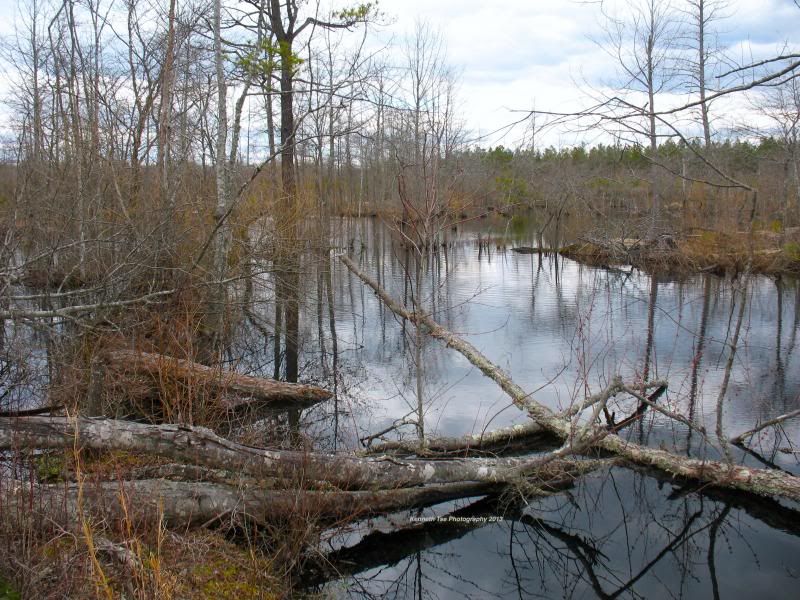
Dressed in waders, our trio started casting little spinners into the dark ruby waters of these blackwater swamps. The water is acidic and dark from tannin. This unique water quality is ideal habitat for some unique species such as Chain Pickerel and the Flier Sunfish. It also prevents invasive species such as Largemouth Bass and Bluegill Sunfish from establishing a stronghold in these little ruby gems.
Chain Pickerel fishing is best during the cold months from December to March. However, on this cool morning our main targets were likely inactive. It was about 30 minutes into fishing when I finally saw a fish ambushed the spinner. However, it was one of these unwanted non-natives.
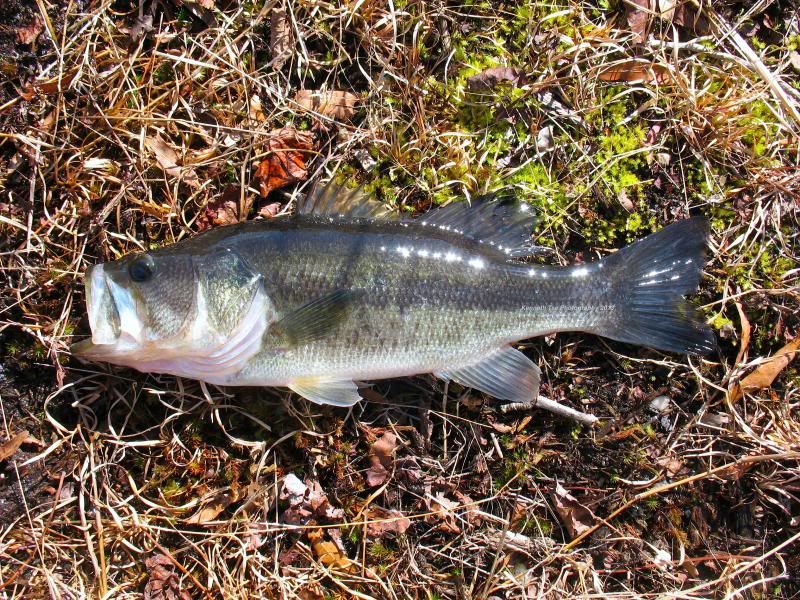
Pat had already fished on entire side of the swamp and now he was directly across from us. As I was wading to the next casting position, I heard Pat’s excited voice as he hooked and landed the first Chain Pickerel of the day. He was too far away for pictures.
Soon, Pat and Michael moved into a back bay to sightfish for some sunfish species. As I arrived in the same area where Pat caught his Chain Pickerel, I saw a swirl of mud and debris about 15 feet from shore. My approach had likely spooked a fish, perhaps one of the elusive bowfin in this swamp. I worked my spinner with a fan cast pattern and about 10 minutes later, a flash of green erupted behind my spinner but missed the lure. I thought the bowfin had come back to the area. To my amazement, my spinner was ripped hard a few casts later and the fish took a couple of strong runs on my ultralight gear. Shaking with excitement, I fought to maintain my composure as a large Chain Pickerel twisted and turned at the end of the line. Finally, I scooped the fish into my little trout net and Pat rushed over to offer some cameraman support. Target species accomplished! It was an awesome Chain Pickerel if I must say so!
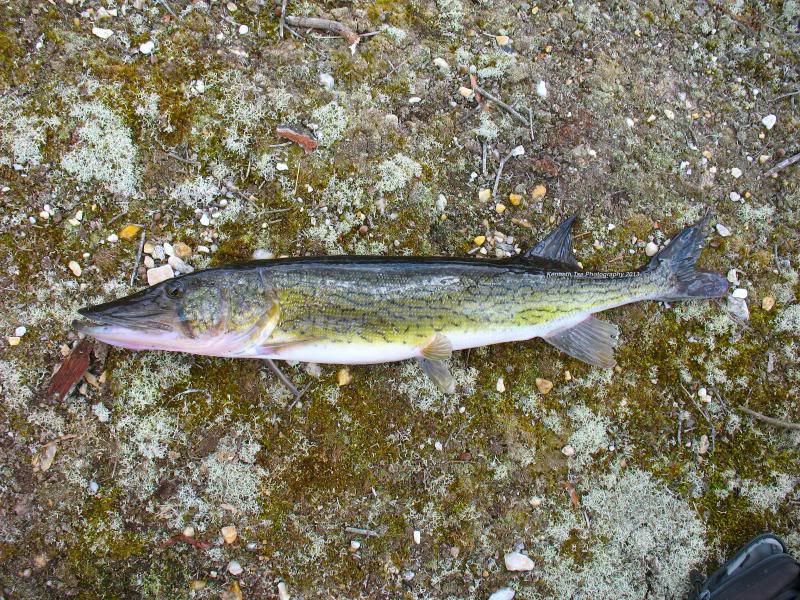
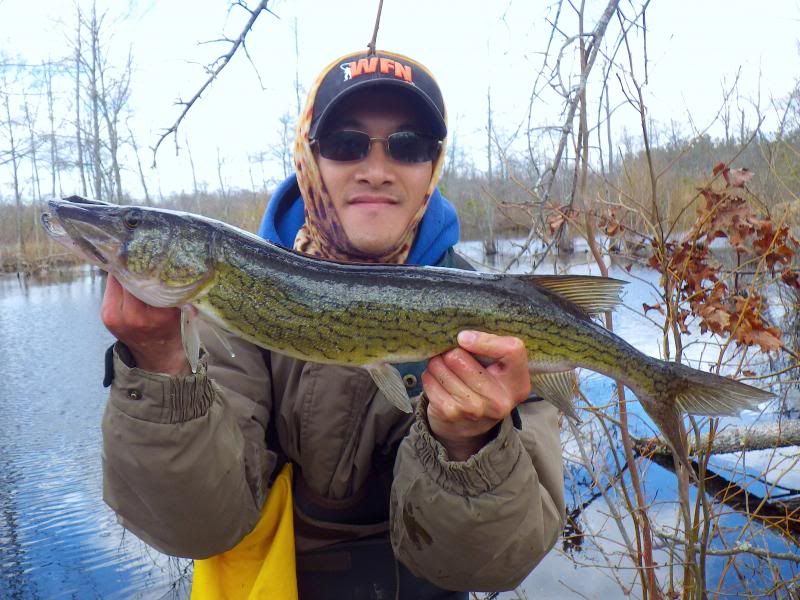
Once I’ve checked off the new species, it was time to switched gear to target the Flier Sunfish. Pat and Michael had already caught some, so I thought it would be an easy feat. Little had I known that these fish were more challenging than expected. Pat suggested to fish a small jighead and Gulp! plastic with a lift-drop cadence. Of course, he didn’t mention that you needed to drop the lure into the weed pockets in order to get bit. This little swamp had a healthy weed growth and we were trying to avoid snagging any weeds for most part. So here I was fishing beside Pat, working the little lure over the tops of weeds and not catching fish, while Pat was teasingly saying “Have you caught a Flier before?”
Finally, I had my chance spotted a Flier swimming in the shallow. The tricky fish gently nipped and spat my jig twice before finally committing on the third try. I had the fish hooked and was just lifting the fish to hand when it shook off in mid air!!! Argh!!!
Meanwhile, Michael was fishing across from us and caught his first Chain Pickerel.
Pat caught a few more Fliers and Bluegill Sunfish plus a couple of Black Crappie before the bite died. At that point, we decided to move onto another swamp to see what it could deliver.
At the end of the swamp, I found a beaver dam with some deeper water immediately upstream of the dam. Perhaps the woodwork would provide good habitat for Flier Sunfish. However, the only inhabitants were a largemouth Bass and three Chain Pickerel.

It was now getting toward 3pm. Pat suggested that he and Michael should try the stream for a Redbreast Sunfish while I spend more time in the first swamp to catch a Flier Sunfish. So we broke off to find our separate species.
Armed with a few nightcrawlers, I tie on a Thill Shy Bite float and a 1/32oz jighead. The chunk of wriggly goodness was irresistible to the sunfish species, but these were initially represented by Bluegill Sunfish. I had to sort through a few Bluegills before something different came on my line. Surprisingly, it was a Warmouth Sunfish! It was not an anticipated target species…but it was definitely a species I had hunt intently in Florida and failed…so it was extremely nice to finally catch one!
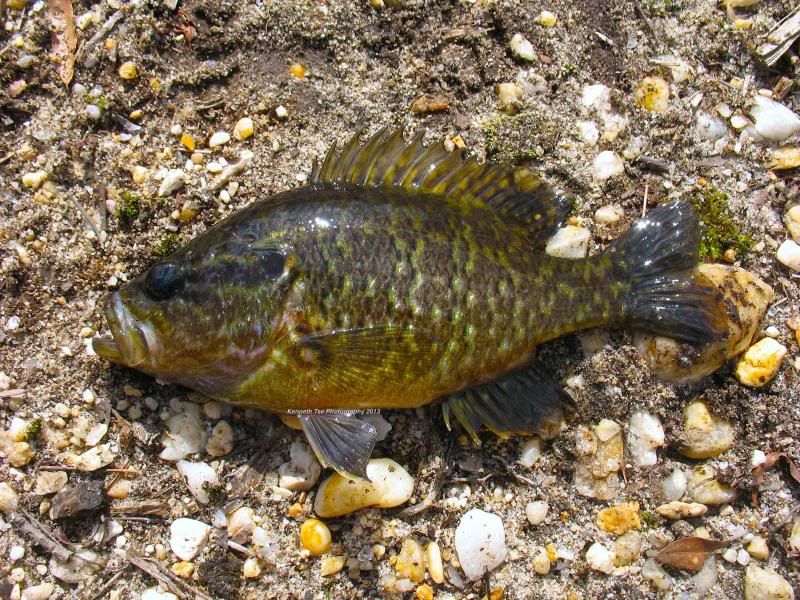
After the Warmouth, a cast toward a pile of fallen branches eventually resulted in my first Flier Sunfish! It was nice to check off another target species!
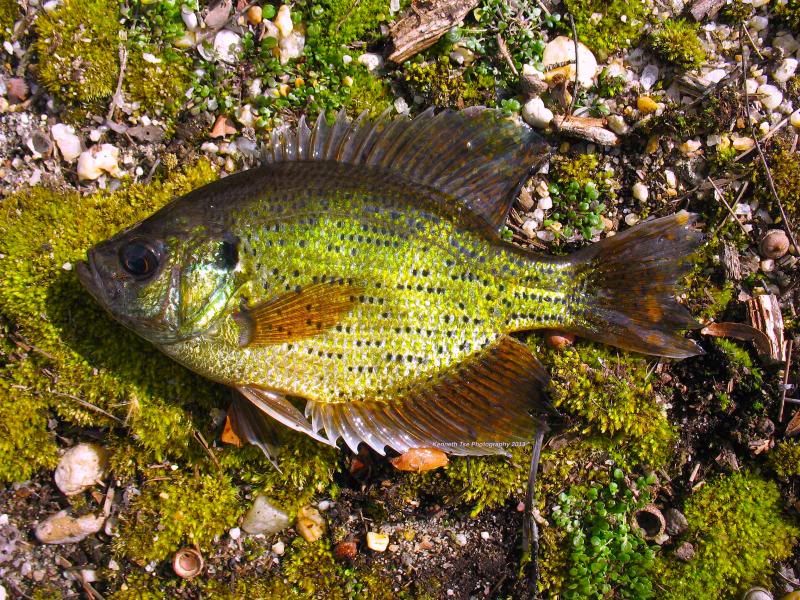
There was also a very beautiful Black Crappie with shades of violet, sapphire, emerald and gold.
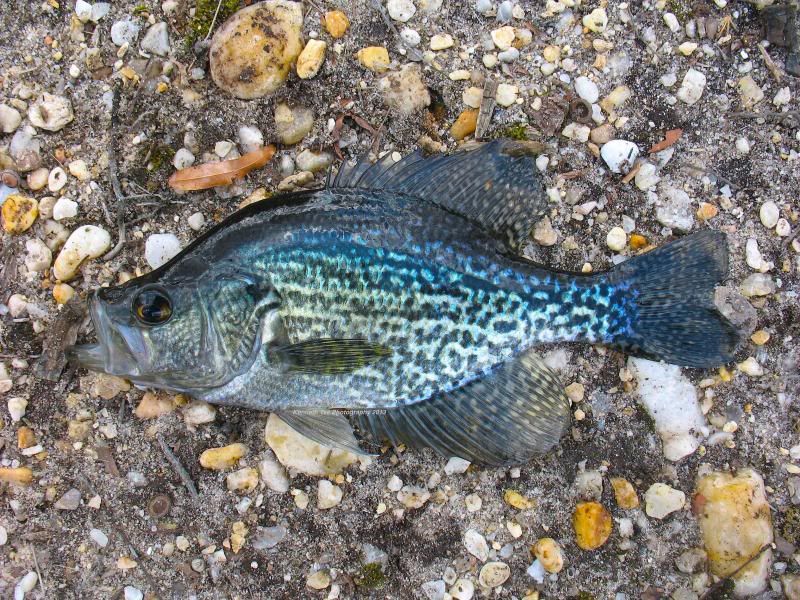
I fished this area until the bite stopped, at which point there was a good catch of 7 Bluegills, 3 Flier, 3 Crappies and the bonus Warmouth. I walked back to the car anticipating that Michael and Pat had already worked their way downstream back to the car. However, they were nowhere to be seen. During the winter, my wader had developed leaks on both ankles and just under the crotch area…so after a full day of fishing, I was completely soaked below the belt and now water was working up the backside of my T-shirt. Seeing it was about 5pm, I decided to take off the waders, dry off and take a nap in the car to reenergize for the drive back.
I woke up at 7pm and just moments before Pat and Michael returned to the car. They had fished the stream where Michael lost a Redbreast Sunfish at hand. Then they fish another pond for bowfin but found none. We left the area just before dusk and if it wasn’t for a couple of accidents, we would have made it back in time to grab some BBQ. Since we were late, we instead ordered a couple of whole roasted chicken from Su Pollo. That was some of the best roast chicken I’ve ever had. I would highly recommend it if you’re in Alexandria, VA!
March 30, 2013
Pat was still recovering from a cold and Lia had unfortunately developed some symptoms. So Pat suggest a couple of spots for Michael and I to explore while he stayed home with Lia. Feeling bad that Michael had lost a Redbreast Sunfish at hand, Pat showed us a warm water discharge where we may find some Redbreast Sunfish.
Perhaps the water was still cold (even beside the warm water discharge) because this area was overpopulated with the non-native Bluegill Sunfish. We had to sort through dozens and dozens of Bluegills before I finally caught a Redbreast Sunfish.
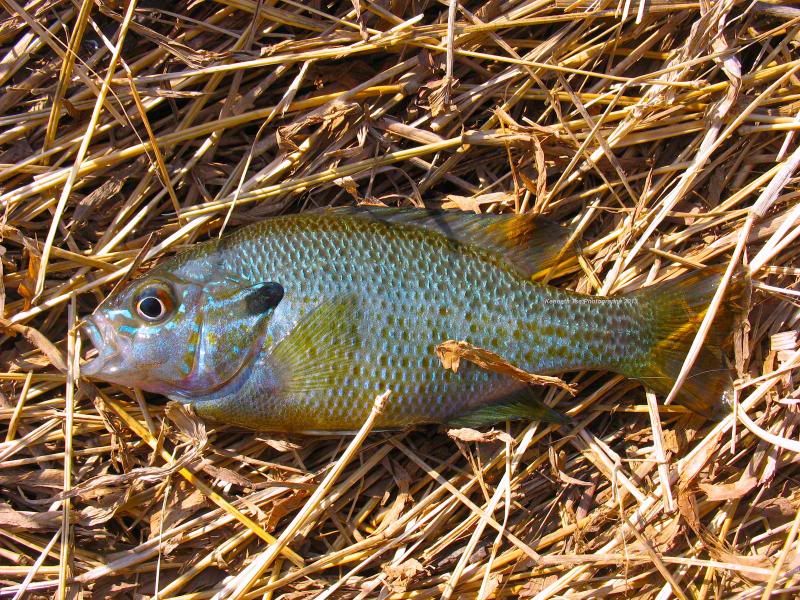
An hour had already gone by and we might just have caught all the sunfish on the upstream side of the discharge. Michael was slowly losing hope but I encourage him to have faith and persist. It would only be a matter of time. Luckily, he caught a Banded Killifish on tanago hooks to keep his spirit up.
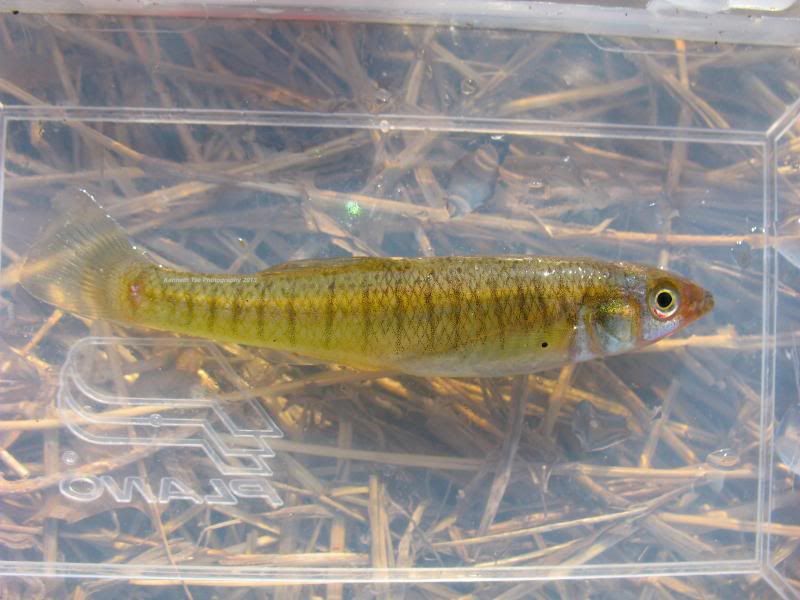
We made a small move to fish the downstream side of the discharge. I had hung up my rod so as not to compete with Michael on his quest for a Redbreast. Dozens and dozens of Bluegills later, Michael finally hooked a sunfish that looked a little more blue and red in the water. It was a Redbreast Sunfish afterall!
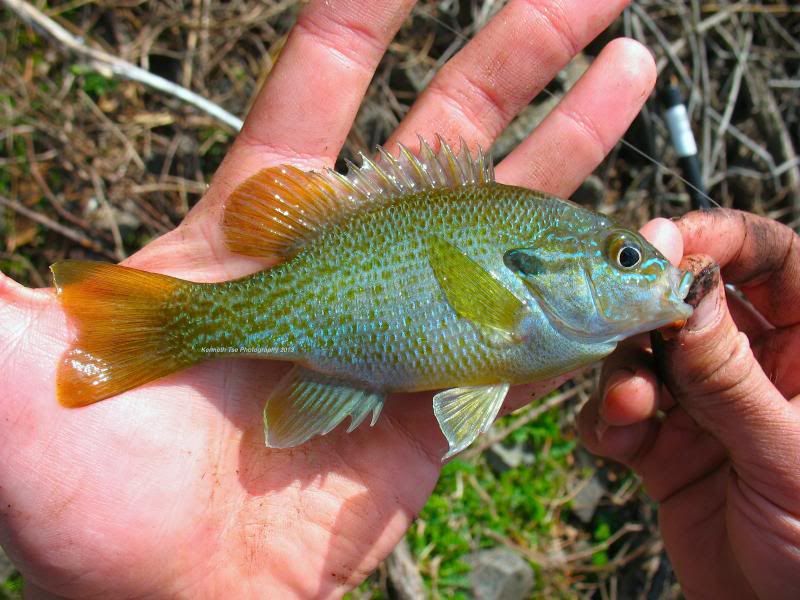
It was now 11:30am and we must make our way to Fletcher’s Boathouse on the DC side. Due to some old land ownership deeds, sections of the Potomac River bottom actually belongs to DC and you must have a DC fishing license even if you’re fishing from the Virginia side of the Potomac. By the time we arrived at Fletcher’s, it was already 12:15pm. We got our licenses and spent a quick 45 minutes fishing from the area for Blue Catfish unsuccessfully. We had initially planned to fish for Northern Snakehead with Pat at 2pm during the low tide period. However, Pat was out cold recovering from his cold so he was not aware we had texted and called him. Instead, we decided to fish for Blue Catfish in the afternoon.
We explored one shoreline looking for a spot to soak a few rods. However, the low tide exposed large mud flats that we simply could not fish. Instead, we fell back to a spot I had fished with Pat last summer.
Michael set up two heavier rods for Blue Catfish while I set up one heavier rod for the Blues and one light rod to fish for bait or anything else that would fancy nightcrawlers. On the Blue Catfish rods, we used 5/0 and 8/0 circle hooks on a fish finder rig. Michael put on a whole Bluegill while I use a cut Bluegill.
It took about an hour before we had the first bite. After a decent fight, Michael brought a 12.6lb Blue Catfish to hand as his first ever Blue.
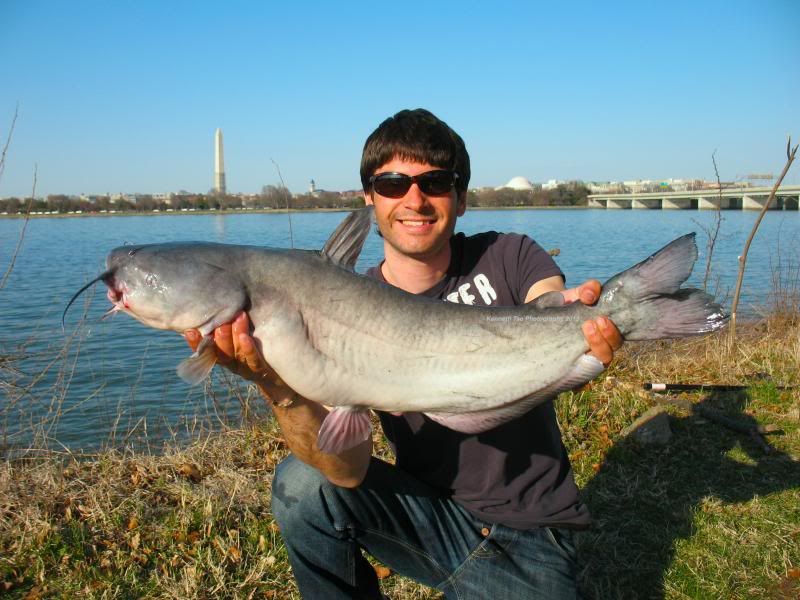
Not long after, he had another bite and landed a slightly smaller model.
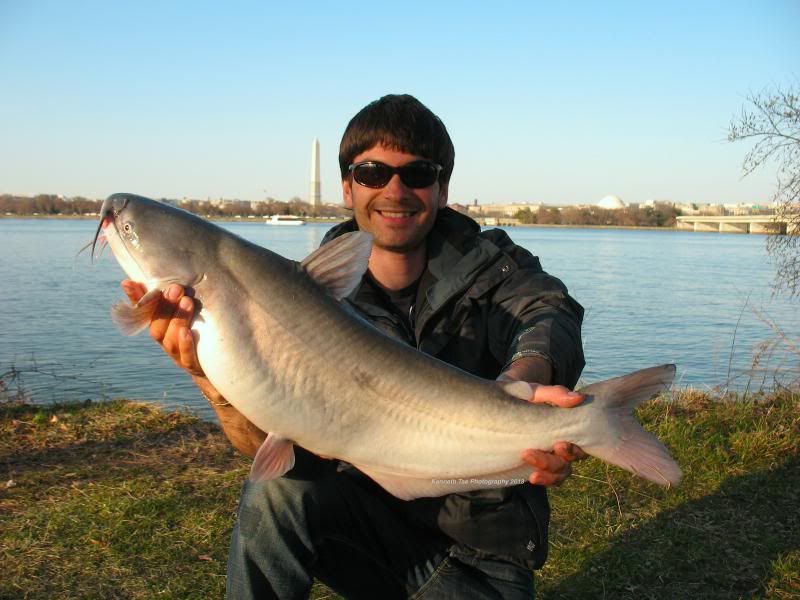
It took another 30 minutes before I hooked up a small Blue.
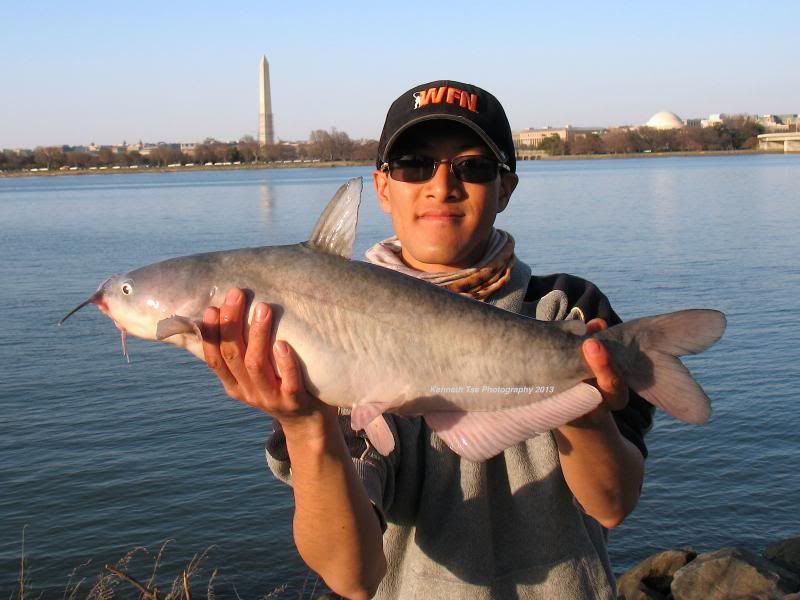
Strangely, as night approach, the bite seemed more tentative instead or more aggressive. We had 3-4 dropped baits before Michael landed the last catfish of the evening at about 3lbs.

Back at the parking, we found a parking ticket on the dash. Apparently, you’re not allowed to back into a parking stall in DC. Weird.
March 31, 2013
Anglers were still reporting very slow shad fishing, but action did picking up each day toward the evenings when water had warmed up. We were also expecting a bit of rain showers toward noon and Pat suggested that the warm rain would raise the water temperature a bit.
With that in mind, we decided to use the morning low tide opportunity for a Northern Snakehead hunt. A week ago, Pat fished at his favourite snakehead location and had a few follows. We were hoping to see a few fish.
A short wade across the creek and we reached a warm water discharge. The bottom is muddy with some weed growth. Although many Largemouth Bass congregated in this area, Pat noticed that other fish species such as carp, koi, and killifish were largely missing. The majority of prey items of the Northern Snakehead were the killifish. With a lack of prey, we did not see a single snakehead after 2 hours of searching. Since the tide was rising, it was time to leave if we wish to cross the creek in dry fashion.
A quick stop at Pat’s apartment later, we were on our way toward the Potomac to a popular location known as Chain Bridge. Upstream of the Chain Bridge, a set of rapids slows the upstream migration of shad. Shad, Blueback Herring and Hickory Shad are the early arrivals while American Shad would join the run a few weeks later.
The rapids define the Fall Line of the Potomac and the river carved deep into the bedrock. For anglers, the climb down to the riverbank can be treacherous. Large boulders, loose rocks and muddy soil were made even more challenging to navigate when wet. Under a light rain, our trio cautiously descended to the waters edge where we picked a boulder for the optimal casting position.
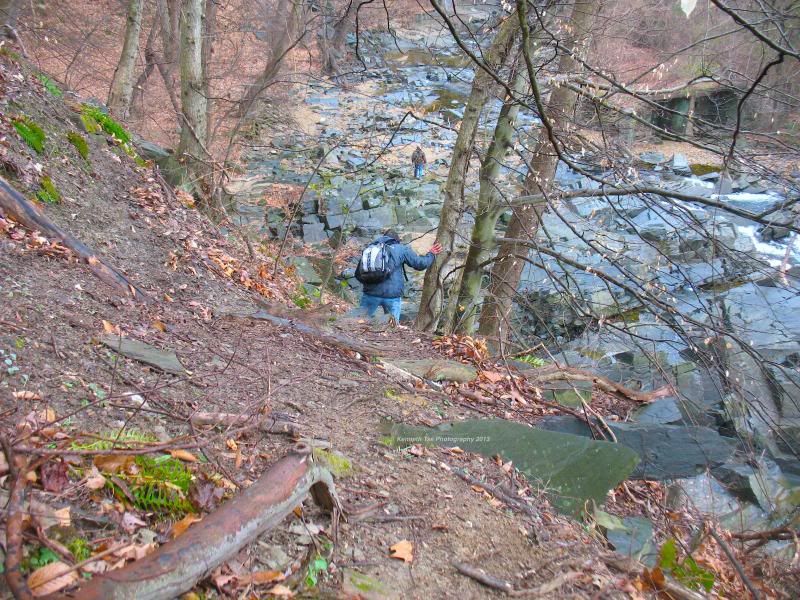
Our ultralight rods were rigged with 4-6lb mono to fish small shad darts or 1/16oz jigs with 2” twister tails. On my rod, I tied on a small pink shad dart with another 1/16oz jig and green/chartreuse twister tail about 2 feet above the dart. The lures were cast into faster current and slowly retrieved into the current seams. Shads often rest in the slower water along the current seams. In many aspects, their upstream movement mirrors many other migratory fish such as steelheads and salmon.
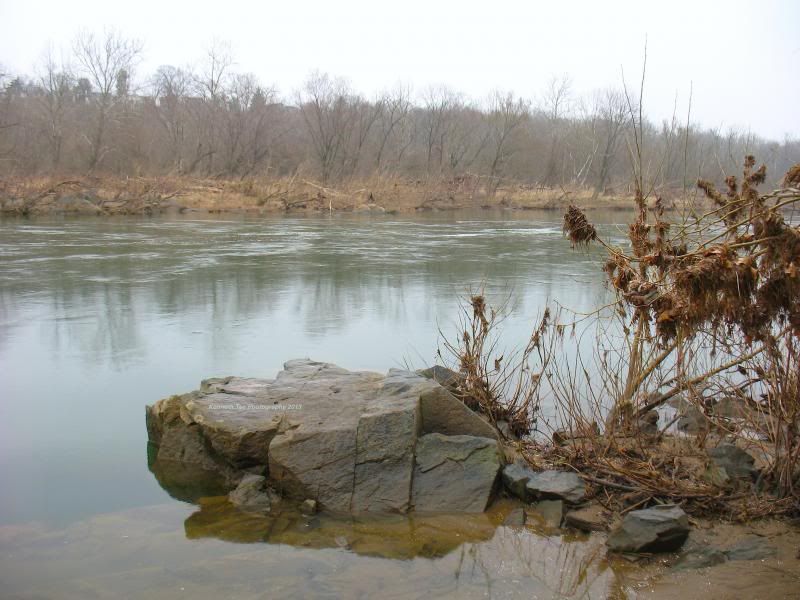
On one of my first few casts, my line had hung up on a branch upstream of my position. After I twitched the rod to free the line, I reeled the lure in quickly while jigging the rod tip to prevent the lures from snagging the boulders on bottom. The lures were about 15 feet from shore when a shad attacked it! Unfortunately, the hit was short and there was no hookup.
I tried a jigging retrieve for about 20 minutes without any further hits. A change in presentation was needed. While speaking to the people at Fletcher’s Boathouse the day previous, we learned that shad prefers a slow presentation. Boat anglers often quarter cast the shad darts downstream and retrieve with an extremely slow pace. I started to cast the dart beyond the current seam and allowed the lure to swing back into the slow water. I’m borrowing the downstream swing technique from my fly fishing toolbox.
Surprisingly, this downstream swing worked rather well. I started to get the odd hits and missed a few fish before one was finally on the line. Unfortunately, the lures often tear out of the soft mouths of these Hickory Shads.
Meanwhile, Michael who was fishing upstream made a small move, made his first cast, and hooked and landed his first Hickory Shad.
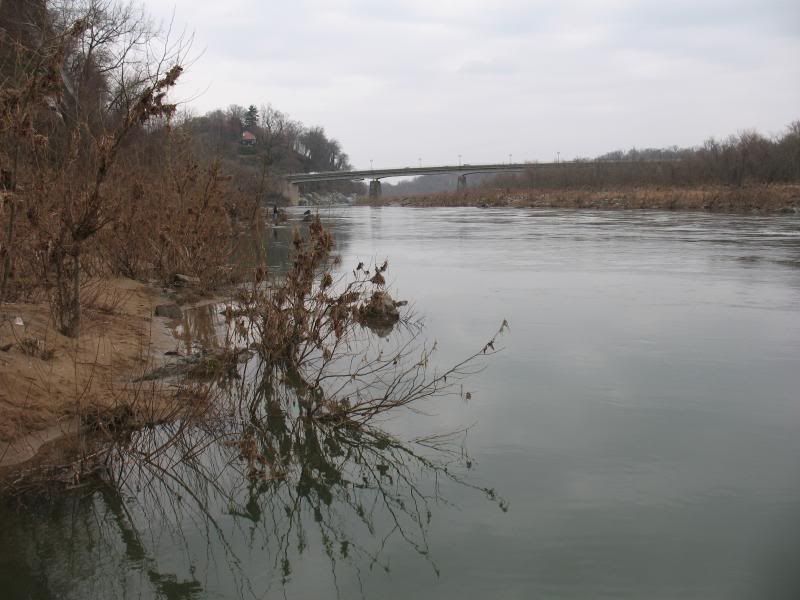
These shads seemed to move in small schools. I would get a few hits or a hookup within short intervals between long lulls of silence. After half a dozen short hits and two missed fish, I finally had good hookset on a fish. Hickory Shad (Alosa mediocris) are amazingly strong and acrobatic fish. Charging runs are punctuated with a stunning aerial display. In every aspect, these fish are mini versions of their tarpon relatives!
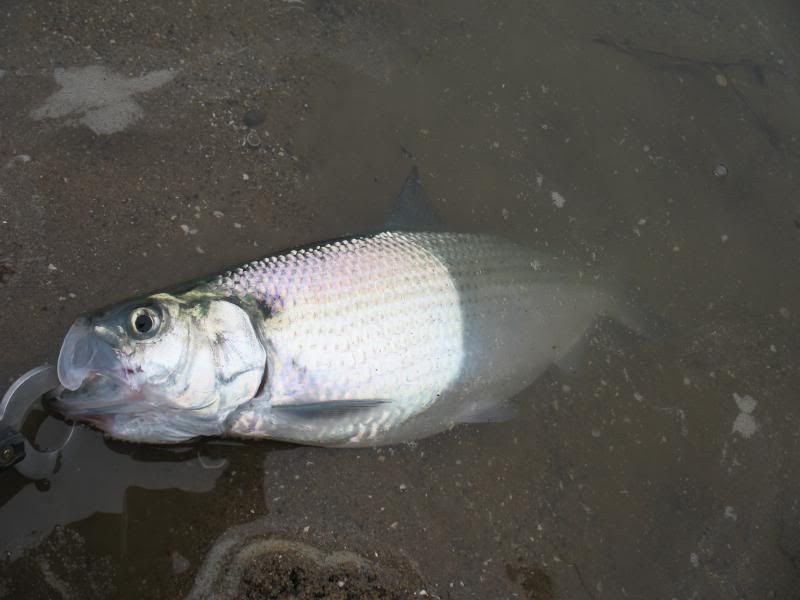
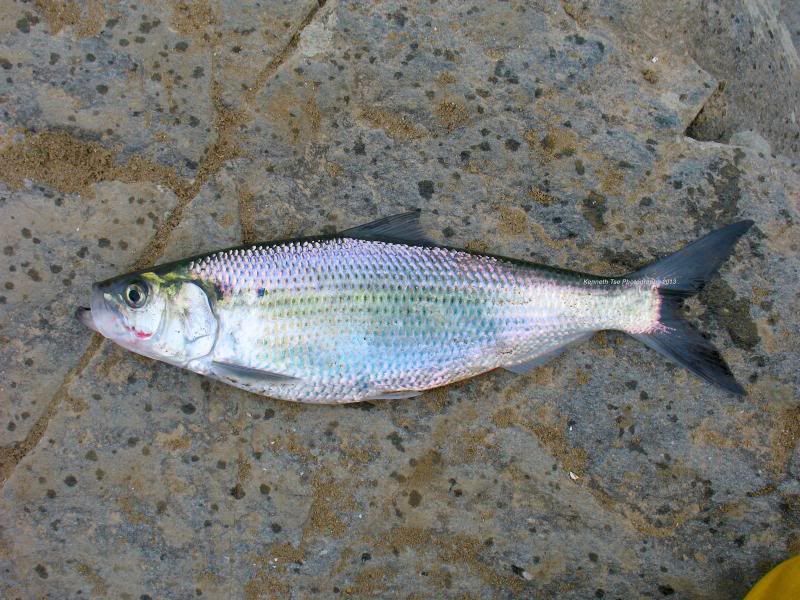
Our timing was not the greatest, but both Michael and I were happy to check off our Hickory Shad target.
We fished for a couple more hours and I missed a few more hits, lost one fish and landed one more Hickory.
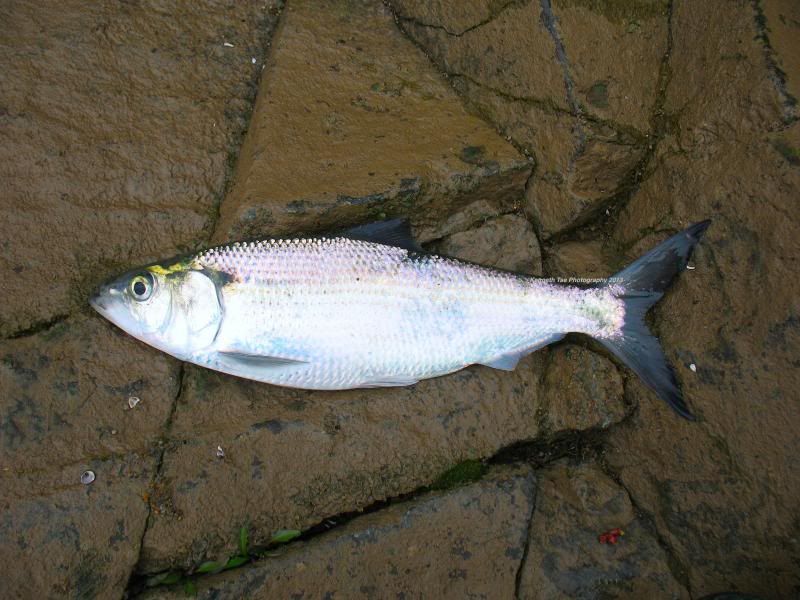
At around 2pm, the fishing came to a halt. Even this far upriver, the tidal influence was evident. It was interesting that during the fury of activity, the tide was approaching high tide. The current was a bit stronger and the current seam was closer to shore. As the water receded a foot on the start of the outgoing tide, the current slowed and seam moved out a little further from shore. We decided to move upstream of the bridge to fish a large eddy right below the set of large rapids.
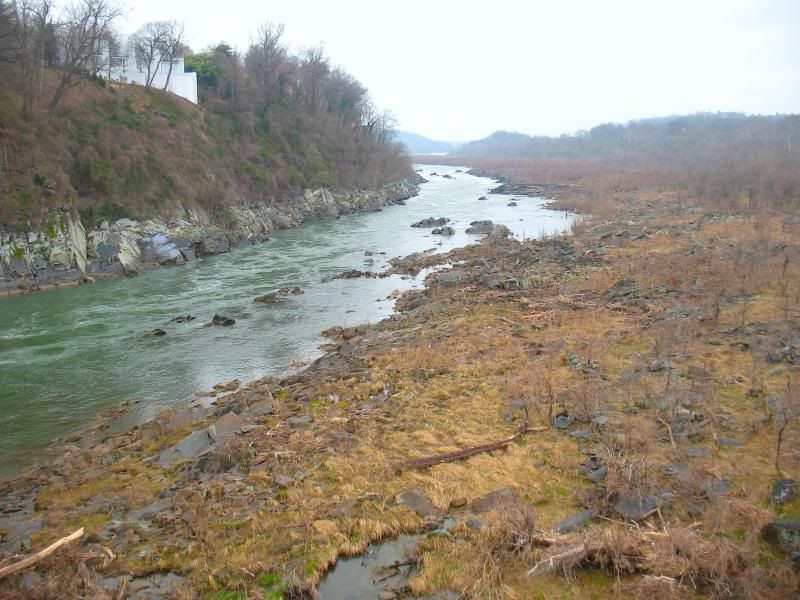
This area was even more treacherous to fish than our downstream location. The rocks were wet with a layer of slippery fine silt and grime. Care must be taken when moving about. A fall into the river could be fatal.
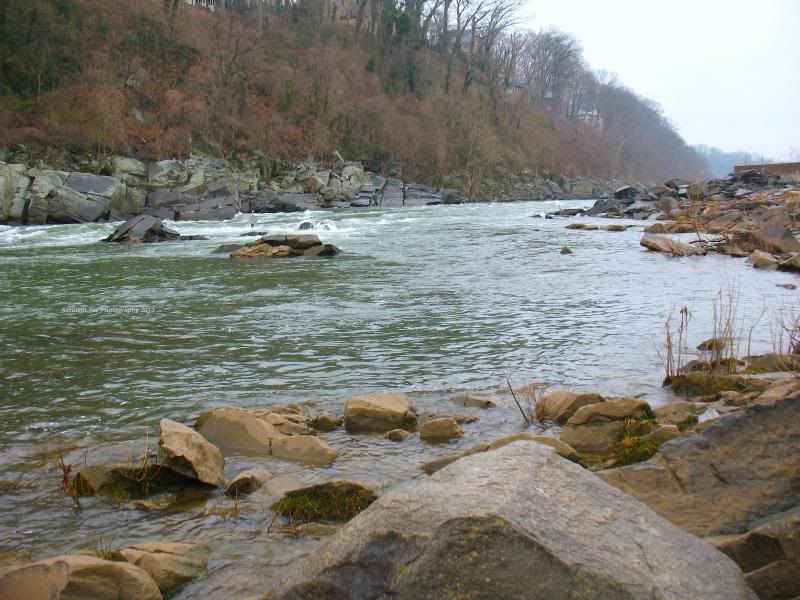
Perched precariously above slippery boulders we pounded the water over and over. Michael was first to hook up with a Quillback Carpsucker that was snagged in the back. This would have been a very nice species to fish for if these fish were actually willing biters. They are very difficult to catch due to the cryptic diet and feeding behaviour.
Finally, I started to get a couple of shot hits and then lost a couple of fish. An hour later, I finally hooked up a Hickory Shad after a sharp hard hit. Strangely, this fish was hooked on the top of the head.
As it was approaching 5pm, we decided to call it a day. Between Michael and I, we landed 5 Hickory Shad while Pat was just enjoying the day. To Pat, this was a very slow day of shad fishing since 100 fish day are not uncommon during the peak of the run. We could only imagine the arm burning fun on one of those days.
We thought about fishing for Blue Catfish in the afternoon, but with limited amount of daylight time, we decided to simply relax for the afternoon.
Back at the apartment, Pat sent Michael and I to order some great kabob dinner from Kabob Palace in Alexandria. This little joint was super busy on Easter Sunday. We had an hour wait for our food, so Michael and I took a little trip to the Tidal Basin on recon mission for future opportunities. As the sun was setting, we only had a brief look at the area, but at least we had an idea the span of that basin and the amount of fishable waters.
April 1, 2013
There wasn’t too much to report on my end. I decided to sleep in since we would be driving back to Toronto. Michael woke up early to fish the morning low tide hoping to find a Northern Snakehead. However, he found none again but there were more signs of life at the warm water discharge. He saw some koi and hooked a possible goldfish. But by 9am, we really had to leave.
Our 9 hour drive was largely smooth going until we were near Rochester where we ran into some nasty snow squalls. But God was watching over us and we arrived home at 9:30pm safe and sound.
Overall, this expedition was extremely successful given the subpar conditions. We later discovered that other shad anglers were either skunked or caught only a couple of fish on Sunday, so our collection of hits, lost fish and landed fish was actually pretty decent. We were happy that the Chain Pickerel were quite cooperative and the Flier Sunfish were not very difficult. I was happy to find a bonus Warmouth Sunfish and even happier that Michael was rewarded with his first Redbreast Sunfish, Banded Killifish and a couple of 10lb+ Blue Catfish.
I’m already thinking about a summer trip back to Virginia to try for Flathead Catfish, a couple of micro sunfish species, and perhaps some more saltwater surf species.




TheJettyRat
Posts: 733
Date Joined: 02/03/12
Well done, some nice
Well done, some nice specimins there. Excelent report and very good pictures. Keep up the good work.
mateusz
Posts: 207
Date Joined: 18/03/11
nicely done
thanks for the great read.
beached as bro!
sea-kem
Posts: 15059
Date Joined: 30/11/09
Going to be seeing it for
Going to be seeing it for myself in a week's tim Ken. Spending 4 days in Washington to check out the sites. So will look at the Potomac and know what's lurking ;) Nice report good to see what fish there are on the other side of the planet.
Love the West!
KenTse
Posts: 139
Date Joined: 23/11/10
Hey sea-kem, I'll send you a
Hey sea-kem, I'll send you a PM tonight for a few spots to try. They're not too far away from Washington (one is actually within the Monument complex). Not sure how much gear you are planning to bring, but there are quite a few opportunities.
bod
Posts: 2321
Date Joined: 03/05/06
excellent
As always Ken, fantastic report and pics. Always interested to see what's happening elsewhere.
KenTse
Posts: 139
Date Joined: 23/11/10
Thanks for the kind words
Thanks for the kind words guys!
Stormfyre
Posts: 8
Date Joined: 06/02/13
Awesome report
Top report. Brought back many memories of my NC days. Got a few small cats too I see. ;-)
cuthbad
Posts: 1266
Date Joined: 22/04/09
good variety of fish there
good variety of fish there hey. Nice work Ken!
KenTse
Posts: 139
Date Joined: 23/11/10
Thanks guys. Yeah, those cats
Thanks guys. Yeah, those cats are relatively small. Too bad we didn't find those 30lb blue cats in the Potomac.
@cuthbad, thanks mate! Hope you can make it next weekend. When the water warms up a little, I'll take you fly fishing. And if time allows, we should go to Caledonia 2nd weekend of May when walleye opens. You can catch all kinds of cool fish there.
When the water warms up a little, I'll take you fly fishing. And if time allows, we should go to Caledonia 2nd weekend of May when walleye opens. You can catch all kinds of cool fish there.
cuthbad
Posts: 1266
Date Joined: 22/04/09
Sounds great man, looking
Sounds great man, looking forward to it!